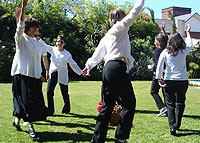

MONTEVIDEO, Uruguay (WOMENSENEWS)–I arrived in Uruguay almost four years ago. It was the seventh time in 30 years of marriage that I had packed up a temporary home to follow my husband to a new posting.
I was suffering from the combined symptoms of culture shock, menopause and being away from my children for the first time. However, I did my best to drag myself out and get involved in activities.
I heard about circle dancing at an ex-pat spouses’ meeting, where Mexican psychologist Rosa del Puerto was trying to drum up support.
She said they included traditional dances from all over the world. Some are ancient; others are modern: they all have simple, repetitive steps and are performed in a circle.
She said she was using the technique successfully to help Uruguayan families cope with the absence of relatives who had moved abroad. The movement, the relaxation, the bonding experience were all therapeutic.
I didn’t detect much enthusiasm at that meeting. One woman asked if it was a sect. To me it sounded faddish, but appealing. After all, I thought, I’ll try anything new to pull myself out of my miserable state and I miss my children.
A few days later I cycled to my first session at a neighbor’s house. It was a bright, crisp fall day and the 10-minute bike ride was invigorating. When I arrived, there was a candle in the middle of the floor, a fire blazing. We greeted each other the Uruguayan way: warm kisses on cold cheeks.
Encircling a Candle
The participants, from Holland, Colombia, Guatemala and the United Kingdom, waited nervously until Rosa encouraged us to stand in a circle around the candle, holding hands.
First we warmed up, moving freely around, waving our arms and twisting our bodies. Then the dancing started.
For each dance, Rosa explained the steps; then we all joined in with the music. I felt anxious, with my two left feet, but I tried to relax, breathing deeply. I found that if I concentrated too much, I clamped up and tripped, and if I concentrated too little, I lost track. After a while I found the right balance.
We did a Celtic dance, one from Turkey, two gypsy dances and a Greek one. The music was new to my ear, varied and melodious. We didn’t talk. We just danced. I felt progressively calmer, and my mind drifted into semi-meditation. After the dances we lay on the floor for a 10-minute relaxation session.
Later, I asked myself, what was that all about? I tried to find some connection in my mind. Clearly, all cultures have traditional folk dances, but who had put together this therapeutic package? We had performed dances from countries and cultures that hated each other, and that had little connection with any of us in the group, yet there we were all holding hands and dancing around in circles like children playing. Who started this trend? And why?
German-Scottish Source

I felt peaceful and centered. Also curious. At home, I did some research, and found that in the 1970s, Professor Bernhard Wosien, a German dance master who had collected hundreds of folk dances worldwide, initiated the practice in the Findhorn Foundation Community in northern Scotland.
Further reading revealed that circle dancing–as I had already experienced after just one session–is beneficial to the whole person: body, soul and mind. As well as reducing stress and physical, emotional and mental anxiety, participants learn to relax in the movement, and each person’s personal space generates self-respect and respect for others. You become more flexible and relaxed in both body and mind because you learn to go with the flow in harmony.
"Anything will sell these days," my skeptical inner voice said.
My real me voice retorted strongly: "Hey, don’t be so cynical. Take whatever works and enjoy it."
Renewed and Ready
I was hooked, and continued dancing with the group. Most dances are gentle and meditative; a few are lively and energizing. All of them make you feel at one with yourself and with your companions. Very soon, my feelings of anxiety and lack of self-worth faded. After a few months, I felt renewed, ready for the challenges of my new life.
Recently, I had the most wonderful experience: Some friends of mine have set up a new organization here in Montevideo, aimed at helping people realize their dreams. Not fancy, expensive dreams but simple, attainable things, as long as others are willing to go along.
I was lucky enough to join in when one of the first dreams came true. A middle-aged woman simply wanted to dance on the beach, so the group invited friends to a session on the beach in central Montevideo.
There was a strong breeze, but it was warm. There were about 40 participants. I knew very few of them, but I immediately felt close as we held hands around an arrangement of flowers and candles.
As the sun dropped below the horizon, one woman’s dream sparked a warmth among us all.
Paola Fornari was born on an island in Lake Victoria, and has lived in a dozen countries over three continents. Her articles have featured in publications as diverse as Ireland’s Own, The Oldie and Practical Fishkeeping.


